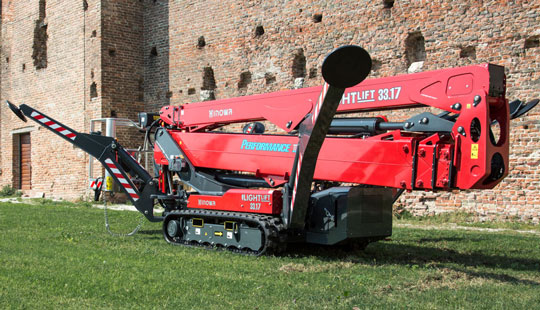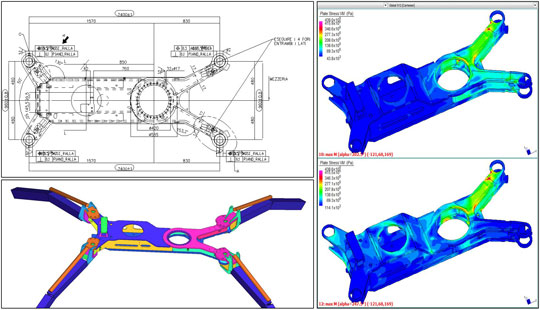- optimize the mechanical behavior of the chosen components
- maximize the performances
- prove the safety of the platform in operation
Named Light-Lift 33-17, the platform has been designed basically for the American market. Operated by hydraulic cylinders, the outreach of the main arm is up to 16.5 m, being 33 m the maximum height. When packed for travelling the platform is extraordinary compact, being the length up to 6 m, lightweight and easy for transportation.
The overturning stability is ensured by 4 outrigger legs positioned during the platform setting up. The payload due to 2 operators housed into the basket is 230 kg.
The platform is erected onto a rubber track-laying wagon, in order to drop the ground pressure underneath the tracks when it moves forward. The endurance limit for the structural parts has been targeted to 40.000 operational cycles, resulting approximately in 10 years of operations.
Category: Mobile cranes
Date: 2018
Max platform height: 30.5 m
Max working height: 32.6 m
Max outreach: 16.5 m
Max payload: 230 kg
Total weight: about 7700 kg


Objectives
For marketing purposes, it was requested to design a lightweight and compact 33 m-height platform (100 ft), resulting the most performing platform among the manufacturer catalogue. Besides, the new design should have fulfilled the American mandatory technical standards.
to be met
The major challenges to be met were strictly related to the overall stability of the platform in any geometrical configuration seeking in the meantime the operational flexibility and the lightness of the assembly. Every item should have been designed in compliance with the technical standards in use.
and results achieved
Based on the goals set out by the manufacturer, a multibody simulation has been implemented in order to investigate the multiple imposed motions, defining the platform working dominium. After the proper model refinement, all the forces transferred by the different structural parts have been computed under the most severe operational conditions. Environmental loads have been included as well.
By sorting out the relevant dimensioning data, the fatigue analysis has been implemented to prove the target life of all the structural elements of the platform. By constantly sharing the analysis outcomes with the manufacturer, the design process has been moving forward smoothly. The structure has been optimized; the weight has been reduced as much as possible without affecting the safety and the overall stability of the platform.
At the end of the iterated design and analysis process, a full-scale prototype model of the platform has been built and tested according to a severe final acceptance procedure. After 40.000 operational cycles controlled by a customized PLC software, the prototype has been disassembled to check the structural integrity of every single item and the wear of the mechanical components. The positive result of the final checking allowed the production to be set up with the full satisfaction of the manufacturer.


